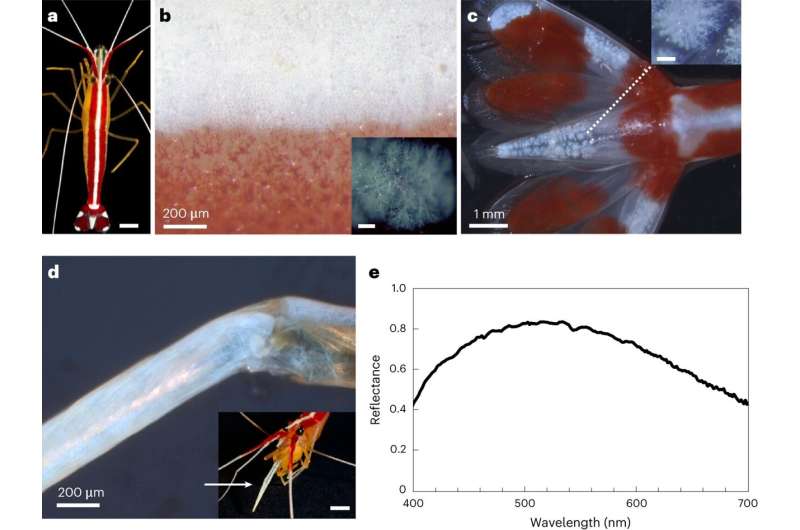April 28, 2023 report
This article has been reviewed according to Science X's editorial process and policies. Editors have highlighted the following attributes while ensuring the content's credibility:
fact-checked
peer-reviewed publication
trusted source
proofread
Scientists find molecule responsible for the bright white coloring of Pacific cleaner shrimp

An international team of molecular chemists, physicists and nanomolecular scientists has found the molecule responsible for the bright, white-colored stripes sported by the Pacific cleaner shrimp. The study is published in Nature Photonics. Diederik Wiersma with the European Laboratory for Non-Linear Spectroscopy, has published a News & Views piece in the same journal issue outlining the work by the team and explaining why it has such pertinence to the creation of photonic materials.
Photonic materials used in solar cells, sensors and optical displays all have thin, white coatings to assist with light propagation. Most such materials are made using titanium dioxide and zinc oxide nanoparticles, which are toxic to humans. So scientists have been looking for an organic source. To that end, they have been looking at animals that have natural white coatings made of thin material. In this new effort, the team focused their energy on learning more about the bright white stripes on Pacific cleaner shrimp.
To learn more about the stripes, the team obtained samples and studied them using microscopy. Then, using optical measurements, they created simulations showing how the stripes interact with light. They found that the stripes are white due to a thin white coating. They also found that the coating was made of extremely thin layers of nanospheres packed tightly together. In watching as light was introduced, the researchers could see it scatter due to the angles created by the nanospheres.
They found that this optical crowding resulted in the stripes reflecting up to 80% of the light that struck them. The researchers determined that the nanospheres were made up of spoke-like isoxanthopterin molecules. These molecules, they found, allowed for efficient scattering even as the nanospheres were densely packed.
The study illuminates the role of optical anisotropy as it applies to light-scattering. And that, the researchers suggest, could help in developing less hazardous white coatings for optical applications.
More information: Tali Lemcoff et al, Brilliant whiteness in shrimp from ultra-thin layers of birefringent nanospheres, Nature Photonics (2023). DOI: 10.1038/s41566-023-01182-4
Diederik S. Wiersma, A shrimp solves a scattering problem, Nature Photonics (2023). DOI: 10.1038/s41566-023-01183-3
How this shrimp gets its brilliant white stripe, Nature (2023). DOI: 10.1038/d41586-023-01415-0
Journal information: Nature Photonics , Nature
© 2023 Science X Network





















